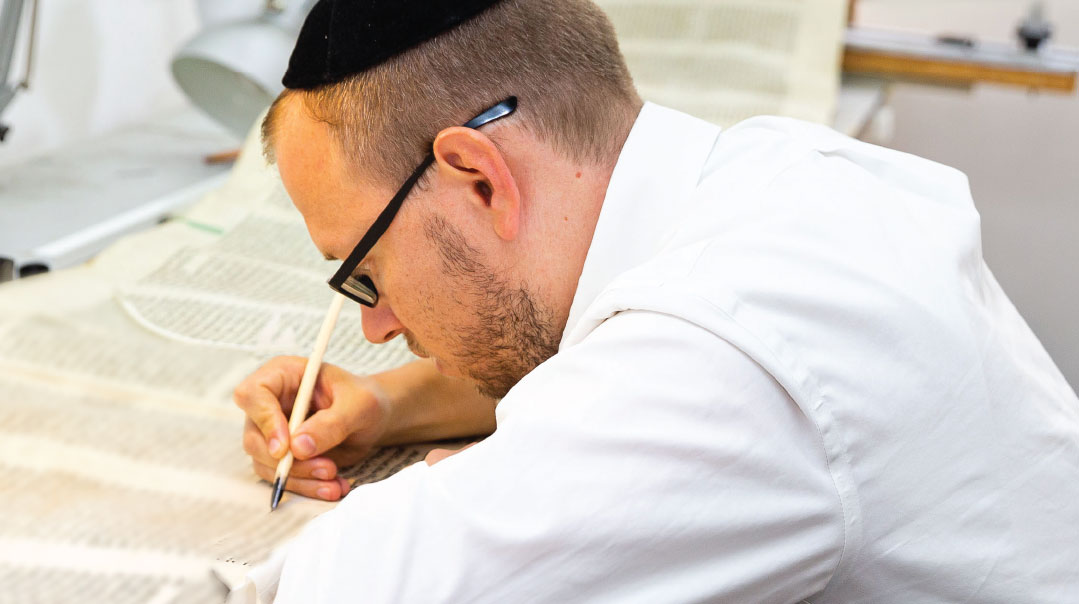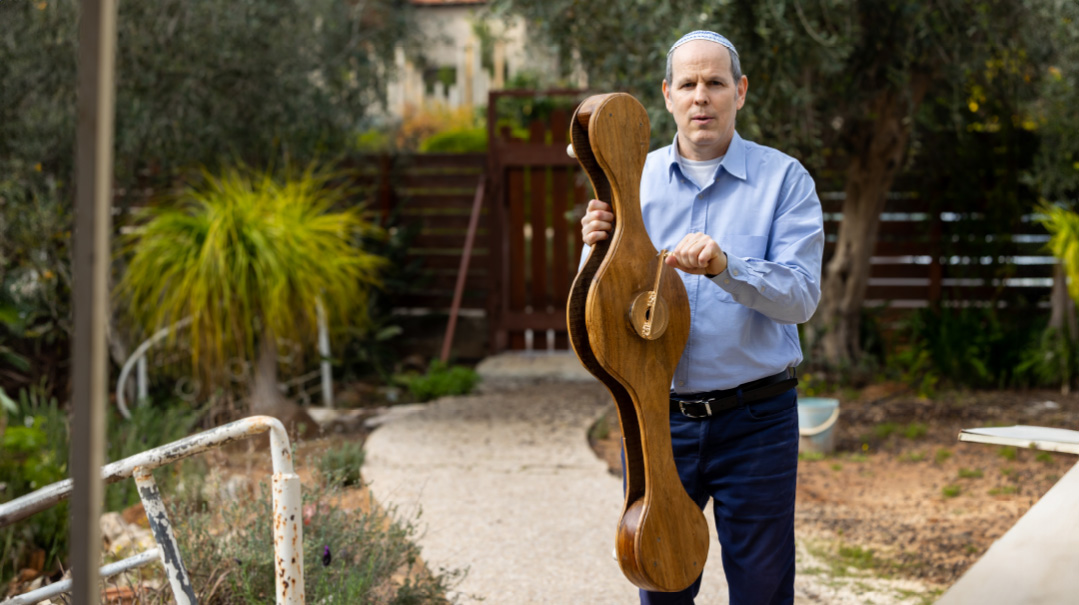Men of Letters
| October 10, 2019
When repairing a Torah scroll, every stitch holds a story

Photos: Elchanan Kotler
Every sefer Torah tells a story, not only by the way they’re written, but by the way people endangered themselves throughout the generations to keep them safe. For the sofrim who restore these ancient scrolls, there’s a message for the future too
It’s been said that a nation that takes no pride in the achievements of its ancestors will never accomplish anything memorable itself. Rabbi Yitzchak Goldstein, director of Machon Ot, is determined to ensure that the Jewish people never loses touch with its most important heritage: the Torah.
Machon Ot (literally: Institute of the Letter) is located on Ha’Uman St. in the Talpiot industrial zone, an area that manages to be at once garish and dingy. Hidden away in the recesses of an ungainly building surrounded by shopping malls and hardware stores, the Machon’s exterior is unassuming. But within it is a treasure house of Jewish history. Founded over 30 years ago with the aim of repairing aged sifrei Torah, the Machon is also a leading authority in restoration and maintenance of Torah scrolls. The Machon works with Israel’s National Library to document ancient and unique scrolls and has compiled a registry of more than 16,000 Torah scrolls across the world.
Based on his decades of experience, Rabbi Goldstein can tell you the age and country of origin of any given sefer Torah, not only through more obvious clues like the mantle and box, but even through the shape of the letters, the width of the columns, and the nature of the klaf.
But Rabbi Goldstein says the individual stories he’s encountered over the years form the chief interest of what he does. “Every sefer Torah tells a story,” he says. As an example, he tells me about a restoration project he worked on several years ago. One day a man called him about a sefer Torah that his grandfather, Theodor Goldschmidt, had brought out of Germany during the war. Theodor had lost his leg fighting in the First World War for Germany and received the Iron Cross for bravery. His leg was replaced with a prosthetic.
Theodor then had three children, one of whom emigrated to Israel in 1935, urging his father to do the same. But Theodor, confident that Germany would never harm a wounded war veteran, refused to abandon what he regarded as his homeland. “Of course,” Rabbi Goldstein observes, “things didn’t work out that way, and at the beginning of the war, the wounded veteran was hauled off to a concentration camp. But before he was taken, he went into the shul, took out a small sefer Torah from the aron, and tied it in place of his prosthetic leg.” He was imprisoned in Theresienstadt for three years, until a German soldier who had served under him in the First World War rescued him and his wife and helped them escape.
“The sefer Torah came to Israel,” Rabbi Goldstein continues, “to Kiryat Tivon [near Haifa], where a shul was founded after the Holocaust. So I repaired this sefer Torah, and the great-grandson of Theodor Goldschmidt went up to his bar mitzvah aliyah with the sefer Torah that his great-grandfather rescued from the Holocaust.
“We fix what needs to be fixed,” he sums up, “but the stories are no less important.”
Torah id
The institute is bustling with activity on an otherwise drowsy summer afternoon when we visit. Boxes of sifrei Torah and machinery are scattered around the small workshop, and the phone is ringing off the hook with prospective customers.
When Rabbi Goldstein and his brother-in-law Rabbi Yitzchak Steiner z”l (who passed away six years ago) founded the institute in 1986, their original mission was repairing aged sifrei Torah. Unlike tefillin (whose broken letters cannot be fixed, as they have to be written in order), the crumbling or missing letters of an aging sefer Torah can be rewritten.
Rabbi Goldstein explains that the staff begins the process by cleaning the klaf with special chemicals. Next they provide it with a coating of a preservative chemical to prevent any further letters from crumbling. Then they go over every single word to ensure all the spelling is correct. At this point the sefer Torah is carried into an adjoining room, where every one of the more than 240 pages is photographed. Afterward an editor — often Rabbi Goldstein himself — sits with a kolmus and corrects the mistakes.
“The biggest compliment I can get,” he says, “is when I’m asked what repairs I made in the sefer Torah. When you can’t even tell what I did, that means I did my job correctly, that the sefer is exactly as it was written 50, 60, 70 years ago.”
Rabbi Goldstein says his own entrance to the field of sifrei Torah restoration could almost be called coincidental. After learning in a Hesder yeshivah in the IDF and later on in yeshivah gedolah, he got married, and was looking for a source of income. His brother-in-law was a sofer stam who introduced him to the field. At first Rabbi Goldstein just did the standard work of writing sifrei Torah and tefillin, but people were also turning to him and Rabbi Steiner with questions when Torah scrolls needed repairs. No one else was in this field, he recalls, so he and his brother-in-law set out to master it themselves. “It’s not the regular field of stam,” he explains. “It’s about preservation, about what to do with crumbling sifrei Torah, how to rehabilitate them. There’s no academic course where you can learn these things. It’s a process of trial and error. You gradually develop methods for what to do to soften a klaf, how to deal with a hole in the klaf, dirt on the klaf, and so on.”
Over the years, the process of repair has been simplified by technology. A computer program developed some 20 years ago has the ability to pinpoint broken words or letters, though it doesn’t catch everything (it’s still necessary to go over the text by hand as well). The Institute also offers a unique service, probably its most popular: a special method of fingerprinting a sefer Torah to prove ownership, in case it is stolen or lost. “If the mantle and atzei chayim are removed from a sefer, how can the owner know it’s his?” asks Rabbi Goldstein. “No proofs of ownership are written on the klaf.” So the Machon takes a picture of one page from the sefer Torah and runs it through a special computer program that was developed, under Rabbi Goldstein’s instructions, by aerospace industry engineers. The program identifies the individual characteristics of every klaf and its style of writing. “It immediately identifies the sefer Torah when a page of it is run through again,” he explains. “Just like fingerprints by the police. No mark is left on the klaf, but it can be identified without fail.” The institute’s Torah ID Program is recognized by many police forces across the world.
Rabbi Goldstein emphasizes that it isn’t only in cases of theft that the identification can prove useful, though there have been several widely publicized cases of stolen Torah scrolls that were restored to their owners because they had been documented by the institute. “For instance,” he recounts, “I once had a customer who knew that his sefer Torah was somewhere in the Ramat HaGolan, but he didn’t know in which yishuv. And because we had fingerprinted all the sifrei Torah in shuls in the Golan, we were able to find it.”
Straight from Baghdad
Over time, the institute expanded its services far beyond repairs, and has become the leading address for every question concerning old sifrei Torah. One of its more important functions is retrieving lost sifrei Torah from countries where the Jewish community has been uprooted. The Machon repairs these Torah scrolls and restores them to kehillos whose founders hailed from that country.
Among the institute’s more spectacular achievements was extracting 54 beautiful sifrei Torah from Iraq toward the end of the previous century. At that time, an Iraqi Arab on a visit to family in Israel showed his cousin’s Jewish employer some yerios of a sefer Torah. Asked by the shocked Jew where he had acquired them, the Arab revealed that they came from the state coffers of former Iraqi dictator Saddam Hussein, who maintained a Judaica collection. The Arab showed him a picture of 400 more sifrei Torah, adding that he could smuggle them out for an appropriate sum of money.
The Jew contacted the institute, which requested to examine the sifrei Torah in Jordan to evaluate their authenticity. The Arab agreed and smuggled 54 of the sifrei Torah over the border into Jordan by concealing them within the gigantic wheels of a truck. The institute examined the sifrei Torah and determined that they were of high quality. “At first he wanted a lot of money for them,” says Rabbi Goldstein. “He started with one million dollars for each sefer. But he couldn’t get anyone to buy them at that price, so after two years he came back to us. Baruch Hashem, we found good people who donated money, and we bought and repaired the sifrei Torah. Now they’re used in Iraqi shuls here in Israel. They were written in the distinctive Iraqi style of sofrus, so they needed to be matched to Iraqi kehillos.”
As the son of Holocaust survivors, Rav Goldstein is most inspired by repairing sifrei Torah from pre-war Europe. He shares yet another story: Several years ago, a group of girls from the Pelech school in Jerusalem were on a visit to Cracow, Poland. As they were wandering in the market, they came to a stand where a Pole was selling little dolls of chassidim. But what caught their attention was that the little figures were also holding what appeared to be pieces of Torah scrolls in their hands. When the girls asked the owner of the stand where the scrolls had come from, he showed them a Torah scroll that he had in his possession, explaining to them that he cut off pieces to put in the hands of his dolls. The girls struck a bargain with him on the spot and bought what remained of the scroll.
However, they still had to smuggle the sefer Torah out of Poland. When they came to the x-ray screening at the airport, the girls kept handing back the backpack with the sifrei Torah to the girls down the line, hoping against hope that they could somehow get it through undetected. When the last girl’s turn came to be screened, the x-ray machine broke, and the guards ushered her through unscreened. “We fixed the sefer Torah — it wasn’t complete — and now it’s used in a shul here in Jerusalem.”
If a Sefer Torah Could Speak
But it isn’t just the hairbreadth escapes and the miraculous heroism of their rescuers that Rabbi Goldstein has come to appreciate over the years. Even seemingly unremarkable details like the formal and often routine inscriptions on the mantle of a sefer Torah, as well as the design of the atzei chayim, can tell fascinating stories.
Rabbi Goldstein picks out an old eitz chayim, which, as he shows me, has a band of writing around the circular disk. In Germany and Holland, he explains, the prevailing Yekkeh custom was to inscribe the name of the owner and the date of the sefer Torah’s writing on the disk. “I have a friend,” he says, “a doctor, called Reine. He’s a pediatric cardiologist in Hadassah from Metz, France. A few years ago he was visiting his native city and he went into one of the local shuls. Without being able to explain why, he asked the gabbai to open the aron kodesh so he could see the sifrei Torah. As he’s standing there, he sees that one of the sifrei Torah is unbalanced. [Formerly, Rabbi Goldstein explains, the handles of the atzei chayim were made of equal length, which made for awkward footing when a sefer Torah was left standing with one disk resting on the other.] So he fixed it in its place. But as he’s turning to leave, he sees it’s falling again, so again he tries to balance it — and again it won’t stay. So he took it out and laid it on the bimah, and arranged a place to balance it in the aron. As he’s about to put it back in, he notices there’s writing on the eitz chayim, and to his astonishment he sees his grandfather’s name written there! So he went to the gabbai and got the sefer Torah and now it’s used in a shul here in Jerusalem. Just think, three times it jumped out at him…”
The Story of am yisrael
Most of our conversation has taken place in the institute’s visiting center, down the hall from the main workshop. Here Rabbi Goldstein keeps a large shelf full of old seforim, mantles, and atzei chayim, which he uses in demonstrations for visitors. He also delivers lectures to yeshivah bochurim, screens documentaries explaining his work, and generally communicates his knowledge and stories to every group of interested visitors, of all ages.
Although the work of repair has been the mainstay of the institute for dozens of years, Rabbi Goldstein says that his most important goal today is education, specifically delivering Torah history to the coming generations. “We’re trying to pass on all these things — teaching children what a sefer Torah is, how it’s written, what an ancient one looks like, what its significance has been for the Jewish people. I think for children especially it’s very important, but also for adults — very few people are familiar with this field; it’s not something you see every day.
“And yet,” he continues passionately, “sifrei Torah tell the story of Am Yisrael. Not only through what’s written in the sefer, but also how people endangered themselves, how people maintained the history of Am Yisrael, generation after generation, 700, 800, 1,000 years — and this isn’t some theoretical, nominal 1,000 years — it’s a sefer Torah that we know is one thousand years old! The very fact that we’re here in Eretz Yisrael comes from there.”
Recently, he adds, a group of non-Jews from Colombia came to the institute for a visit. At first, he wasn’t sure he wanted to show them around, but they convinced him with a letter of recommendation from a rabbi of the Jewish community in Colombia. They want to understand Judaism, the rabbi wrote. They weren’t going through geirus and they weren’t missionaries.
“They sat here and asked me questions,” Rabbi Goldstein explains. “How a sefer Torah is written, what are the materials, the ink; and I showed them the different parts of the operation, what’s done. At the end I told them, you asked me many questions. I have just one question for you: Why did you come? Why is this even important to you? They told me, those who write sifrei Torah are close to the Creator, and we want to be close to them. That was their answer.
“So why do we need them to come searching for this when we can pursue it ourselves? These are our Eternal Letters. The Torah is what has kept us through the ages.”
(Originally featured in Mishpacha, Issue 781)
Oops! We could not locate your form.







